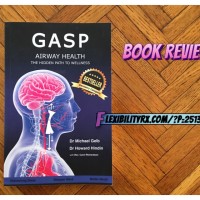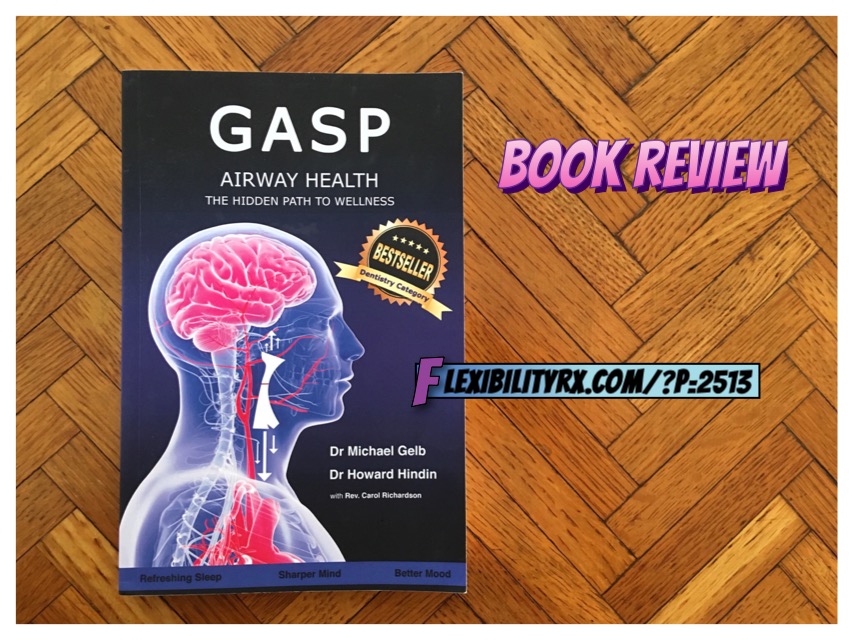
Saturday: Reviews & Recommendations (Book Review)
GAPS: Airway Health – The Hidden Path to Wellness
The most important question I ask myself regarding a new patient is, “How well do they breathe?”
Are they living in their body? Can they both properly use the diaphragm as both a postural and respiratory muscle? Can they breathe through their nose?
My job in rehabilitating patients is empowering someone to preserve their airway.
Cervical alignment, nutrition, and sleep all affect the airway.
The Postural Restoration Institute points out that, “Sometimes your best physical therapist is a dentist.”
Chronic pain patients who have ligament laxity from whiplash or individuals with less than ideal genetics may need to seek out a PRI therapist, dentist, or Myofunctional therapist.
This post will not focus on treatment of an obstructed airway but will instead first bring attention to the signs and symptoms of a compromised airway.
In future posts, I will discuss how regular use of a Netti Pot, good sleep positions/pillows/mattresses, and appropriate exercise can help restore alignment, respiratory function and biomechanics.
#1: What is Airway Obstruction and What are the Consequences?
“Improper breathing and sleep patterns adversely affect health, mood, energy, focus and function, and if untreated will ultimately lead to multiple systemic disorders. We refer to this constellation of disorders as Hidden Airway problems since they so often go unrecognized.
These problems express themselves in many ways, and typically the symptoms are treated but not the underlying problem. As a result, new expressions appear and they are treated with medications, surgery and other interventions. But the continued struggle for adequate breath leads to persistent inflammation and an assortment of chronic diseases.
Non-restorative sleep leads to poor focus and function, as well as interruptions in growth, development and learning. Recently, even Alzheimer’s disease, dementia and cancer have been linked to airway/sleep problems.”
#2: What Factors Can Lead to an Obstructed Airway?
2A: Poor Nutrition Influences Facial Structure
The biggest factor in the heightened prevalence of airway obstruction is the affect poor nutrition has had on successive generations.
Weston A. Price, a renowned dentist, traveled the world studying the teeth and facial structure of cultures that did not yet adopt a Western diet.
What he found is that hunter gatherer populations that consumed a Paleo style diet did not have narrow retracted faces/sinuses whose jaws had narrowed and teeth came in crooked.
Nutrition which influences facial characteristics will affect a population’s ability to breathe. This will become amplified over time across multiple generations.
Part of this involved the consumption of non-cooked food that was harder to chew. There was no malocclusion (bad bite due to poor development of the jaws) in these cultures before Western diets were introduced.
“It is called the Hidden Airway problem altering the lives of 50% of us. We call it HIDDEN because it is often not looked for; it goes unrecognized and untreated.”
“Smaller jaws leave less room for teeth, causing crowding. They also leave less room for the tongue, forcing it to move backwards, especially during sleep, where it tends to block the airway. A long narrow face is an indicator of an airway obstruction as the body struggles to breath.”
2B: Environmental Toxins
“One of the most researched issues of exposure to pesticides and dioxins is the increased prevalence of cleft palates in children. We also know that pollution causes increase in asthma and allergies. Allergies in turn lead to sleep-disorders in children and adults.”
2C: A Decline in Breast Feeding
“When the airway is established with breast feeding, allergy treatment – neurocognitive and neurobehavioral problems are greatly improved – often without any medication.”
“Breastfeeding of infants is a primary factor in normal facial development because the newborn’s sucking action (which is not replicated in bottle-feeding) develops muscles critical to proper airway development.”
This reminds me of Tom Myers discussion of how birth has been turned into a disease process. Medication is over utilized preventing normal inducement of labor. Instead of a normal squatting position and use of water birthing women are laid on their backs in hospital beds.
Pre-mature babies tend to be mouth breathers. Over reliance on medication and C-Sections affect the immune system of the child as well as the microbiome of the developing infant is inherited via the mother through vaginal birth.
There are of course exceptions, pre-diabetic mothers tend to need the Western birthing process (hospital support) but C-Sections have been greatly over utilized in non-at-risk situations. Breast feeding also went out of favor as processed and chemically laden foods were adopted as replacements.
https://www.orgasmicbirth.com
2D: Practices of Modern Dentistry
“How’s a dentist going to fix behavior? Understanding the domino effect of undiagnosed allergies helps. The allergies cause the nasal passages to be chronically swollen. When someone cannot breathe through their nose, their only other option is the mouth. Mouth breathing 24 hours a day over a number of years takes a toll on the development of the mouth.
When Children breathe through their mouths during sleep, the increased turbulence of the breath going directly into the throat instead of going first through the nose causes inflammation and enlargement of the tonsils and adenoids.
A higher arch is developed in the palate; the jaw is no longer able to accommodate the tongue; the tonsils and adenoids work harder and can become enlarged. All of these things contribute to snoring.
Fix the mouth, snoring goes away, a full night’s sleep is achieved, and behavioral dysfunction is remedied.”
The authors point out that this lack of understanding has contributed to disadvantageous practices in the field of dentistry including teeth pulling and removal of tonsils and adenoids.
#3: Signs and Symptoms of Airway Obstruction
The following lists discuss symptoms of sleep disorders and of an obstructed airway…
Sleep Disordered Breathing Symptoms
Headaches
Snoring
Difficulty sleeping
Neck, jaw, or ear pain
Junk food cravings
Obesity
Diabetes
Cardiovascular disease
Mental fog
Lower energy
Chronic fatigue
Signs of Airway Obstruction
Mouth breathing
Snoring
Chronic nasal discharge/runny nose
Chronic ear infections
Restless sleep
Crooked teeth
Frequent earaches
Falling asleep during the day
Unrefreshing sleep
“Even if a child who suffers from cognitive impairment and poor performance in schools gets to bed Early Enough they could still have problems with fatigue, focus, and learning.”
“One study found that 82% of diabetics have obstructive sleep apnea. Studies also show that sleep-disordered breathing leads to glucose intolerance and alters the body’s ability to process glucose.”
#4: An Airway Centric Approach
Dr. Michael Gelb is a pioneer in bringing attention to sleep related disorders. He created what is known as a Gelb appliance which can restructure the mandible and help with temporomandibular disorders.
Doctor Michael Gelb: TMJ, headaches, sleep disorders / sleep apnea specialist
Gelb Appliance: https://www.ncbi.nlm.nih.gov/pubmed/1811812
“Facial structures can be optimized if they are constructed around an open, well-functioning airway. This requires collaboration between pediatrician, ENT, allergist, pediatric dentist, orthodontist, speech languet pathologist and myofunctional therapist. GASP will help find and build the airway team for you.”
His book provides some action steps to combat airway obstruction…
See and dentist and have your airway checked
Undergo a sleep study
Consider a CPAP machine*
Avoid having teeth pulled, as this shrinks the jaw
Follow a regular routine of good sleep hygiene (provided in chapter 13 of this book)
*While a CPAP machine can alleviate many of the symptoms of non-restful sleep and open the airway, I don’t consider this to be a viable long-term solution for an obstructed airway.
The Postural Restoration Institute (Hruska Clinic) specializes in dental integration with physical therapy to provide long term relief.
– Kevin J. Kula, “The Flexibility Coach”




Leave A Reply (No comments so far)
You must be logged in to post a comment.
No comments yet